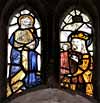For this church:    |
Lambley Holy TrinityGlass
The 1847 survey by Bowman and Hadfield states: There are a few fragments of stained glass in the chancel windows, but none sufficiently perfect to merit either representation or description There is no mention of the three panels in the east window. These consist of a crucifixion, a Virgin and child and a virgin or saint. Close examination shows that they are made up of fragments of glass ranging from the 13th to the 15th Centuries. The question is: Where were they in 1847? The crucifixion panel is the most complete panel and dates from the 15th Century. The Virgin and child is made up of 13th, 14th and 15th Century fragments. The Virgin is almost complete in a typical 14th Century pose offering her breast to the infant, who is not contemporary with her but taken from a standing Christ child who is untypically facing away from her (cf Deerhurst) The background of this panel is 13th Century oak trail. The third panel is an almost complete virgin or saint in yellow robe and blue cloak mainly 15th Century but with some 13th Century fragments. The background to the east window is arranged in a diamond pattern of white and yellow quarries typical of the mid eighteenth century suggesting that the three panels were inserted in their present position when the church was repaired in 1855 The chancel windows still retain their fragments of 13th Century grisaille, a variety of borders and oak trail. In the top left hand corner of the south chancel window is the remains of a donor kneeling at a prie dieu, part of the figure has been removed and replaced with white glass. The leadwork and glazing of the chancel and nave windows appear to be 18th Century, although some of the upper portions of the nave are earlier and contain a few 15th Century quarries. In 1637 the churchwardens were presented to the Archdeacons Court for ‘parsonage house out of repair’ and ‘windows of chancel out of repair’ The churchwardens accounts for the 18th Century contain many references to payments to blacksmith and glazier for window bars and stays and for glazing. The white quarries in these windows are 18th Century. |






